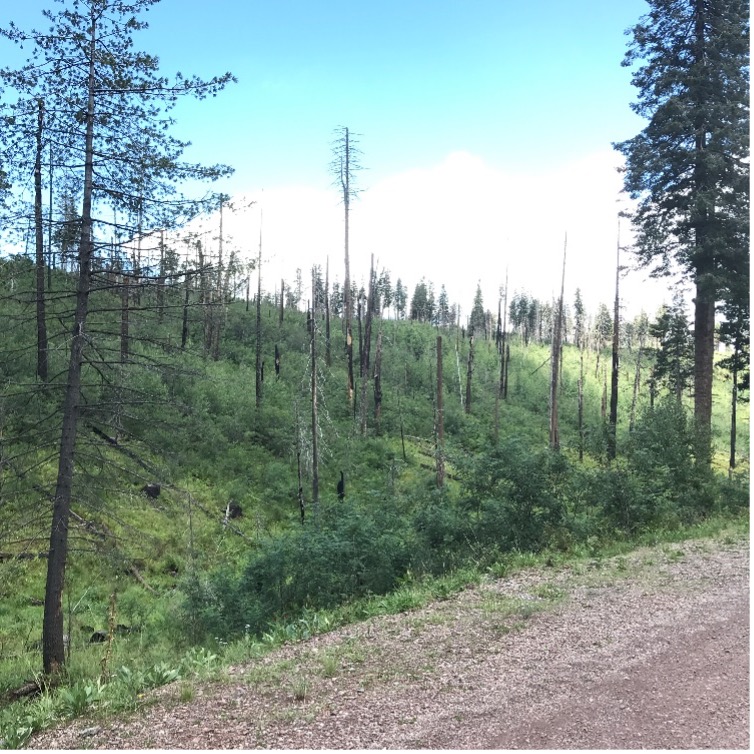After the Fires: Seed Banking Goodding's Onion on USFS Lands
Wildfires can have a devastating impact on rare plants, destroying habitats and causing population declines for species that are already under threat. Such is the case for Goodding’s onion (Allium gooddingii), a rare species of wild onion found in high-elevation mixed conifer woodlands in the mountains of Arizona and New Mexico. This species has demonstrated difficulty recovering from wildfire events. NatureServe ranks Goodding’s onion as imperiled (G2), and the US Forest Service rates it as sensitive in Arizona and New Mexico. It has been a candidate for listing by the U.S. Fish and Wildlife Service, but is not currently listed as federally threatened or endangered.
Preferring the deep shade provided by mature trees in their habitat, Goodding’s onion populations have been heavily impacted by wildfires in recent years. In 2020 alone, Arizona experienced 2,520 wildfires (65 larger than 1,000 acres) and New Mexico experienced 543 wildfires (13 larger than 1,000 acres). Several of these wildfires were classified as high-severity burns that scorched the soils and killed every tree—effectively destroying the habitat and environmental conditions that Goodding’s onion needs to survive and thrive. Such a drastic change in landscape also allows primary succession species, such as New Mexico locust (Robinia neomexicana) and Quaking aspen (Populus tremuloides), to dominate the space, further restricting Goodding’s onion in areas where it was once abundant. The rise of wildfires in the American Southwest as a result of climate change make it imperative to conserve seeds of this imperiled species in long-term storage for use in future forest restoration projects.

Happily, the Center for Plant Conservation (CPC) was awarded funding as part of a five-year agreement with the US Forest Service (USFS) to support strategically rare plant populations located on Region 3 USFS land, securing them in conservation-quality seed collections through CPC’s network of botanical gardens. In Spring 2021, USFS Regional Botanist Dr. Kathryn Kennedy identified Goodding’s onion as a priority species for these seed collections—specifically due to the population declines the species has experienced in recent years following wildfire events. The Arboretum at Flagstaff, a CPC Participating Institution, has over 37 years working with Goodding’s onion. Three collections of seeds in long-term storage from the 1980s and an ex situ population cultivated at their botanic garden make the Arboretum an ideal partner to collect new seeds of this species to refresh the collection.
“For the past several years, CPC’s work with the Forest Service has focused on securing rare species not previously in conservation seed collections,” shared Dr. Katie Heineman, CPC’s Vice President of Science & Conservation. “This project, however, is an important reminder that seed collection priorities for ‘secure’ species need to be revisited in response to imminent threats—such as the devasting wildfires in Arizona—and as seed collections begin to age.”
In summer 2021, the team from the Arboretum at Flagstaff visited over a dozen historical populations of Goodding’s onion affected by recent wildfires and made three conservation seed collections according to CPC Best Practice Guidelines. They also coordinated the storage of seven additional collections made by USFS partners and the Navajo Nation Heritage program. The National Forests represented by these collections include Apache Sitgreaves National Forest, Coronado National Forest, and Lincoln National Forest. All of the seeds were sent for safety duplication to the National Laboratory for Genetic Resources Preservation (NLGRP) in Fort Collins, CO. In total, this project has resulted in the banking of ten seed accessions from nine wild populations, totaling 7300+ seeds from more than 800 maternal plants.
“It has been startling to see all the damage from the major wildfires in the Goodding’s onion habitat,” said Sheila Murray, Conservation Botanist at The Arboretum at Flagstaff. “Many of the populations that we had been to in the past were completely consumed by wildfire. We were however able to secure seeds from nearby known populations and a few newly discovered populations. We hope that these burned areas will eventually recover enough in the future to support the species once again.”

As next steps for this ongoing partnership with the USFS, CPC will continue working in 2022 with the Arboretum at Flagstaff’s team to make further seed collections of Goodding’s onion or the vulnerable Arizona Sneezeweed (Helenium arizonicum). CPC will also partner with the Institute for Applied Ecology to make a seed collection of a to-be-determined species. Seed banking remains a fundamental conservation action to protect and preserve rare and imperiled plant species in the face of myriad threats. It is through partnerships like this that CPC’s network can be most effective in our shared mission to Save Plants from extinction.


